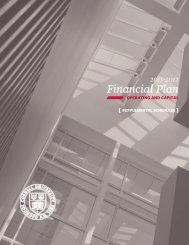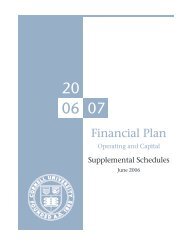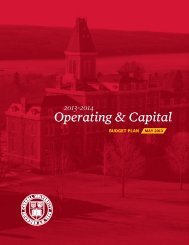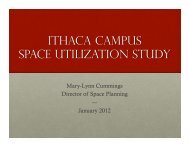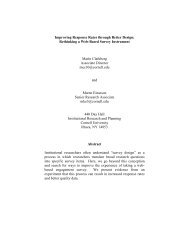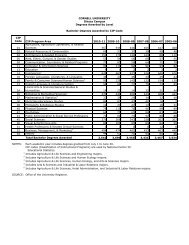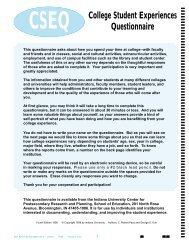Tuition, <strong>Financial</strong> Aid & Endowment7%. The overall payout ratio on educational institutions’endowments fall below this level. One option would beto require a payout rate; or to require a payout rate (ora higher rate) for institutions as long as their per studentendowment is above a fixed amount. Alternatively, onecould relate the payout rate to the earnings rate so as topreserve the real value <strong>of</strong> the endowment and perhapssome small growth, but not allow it to grow so rapidly.Another option, if the public policy concern is aboutaffordable education, would be to impose a tax on theendowment for schools with tuition increases over apre-determined threshold.IRS Tax-Exempt ConcernsThe Internal Revenue Service (IRS) has also expressedapprehension over the same issue. As reported recentlyin the Chronicle <strong>of</strong> Philanthropy, 2 Steven Miller,the commissioner <strong>of</strong> the Tax Exempt and GovernmentEntities <strong>Division</strong> <strong>of</strong> the IRS, said that the IRS was concernedthat many organizations are not making effectiveuse <strong>of</strong> their assets, given their tax-exempt status.“Is providing a peppercorn <strong>of</strong> public benefit enough fora tax exemption?” Mr. Miller asked. “How much savingsis too much savings? Should we insist on behalf <strong>of</strong> thepublic that the charity provide a public benefit that iscommensurate with the charity’s financial resources andwith the tax subsidy it receives?”The article describes Mr. Miller as saying that:…the IRS may want to consider a payout requirementfor charities that is similar to the annual requirement forprivate foundations, which must distribute 5 percent <strong>of</strong>their assets each year. He said the agency may also useits enforcement tools to crack down on charities thatare hoarding assets without providing much benefit tothe public.“We should review existing tools and explore whether wecan hold organizations to a standard <strong>of</strong> commensurateuse <strong>of</strong> assets, at least in the most <strong>of</strong>fensive or egregiouscases,” Mr. Miller said.He said the IRS may review how foundations are complyingwith the requirement to spend at least 5 percent <strong>of</strong>their assets each year. Critics have suggested that somefoundations include too much administrative overheadin meeting the 5-percent threshold.“It may be time for us to review what is being spent andcounted,” Mr. Miller said.2 Gose, Ben, “IRS Official Says Tax Agency May Step UpEfforts to Identify Ineffective Charities.” The Chronicle <strong>of</strong>Philanthropy (Nov. 12, 2007). http://www.philanthropy.com/news/updates/index.php?id=3441The article noted that some who believe that the IRSmay be moving beyond its legal mandates viewed Mr.Miller’s comments with concern.Marcus S. Owens, a Washington lawyer who is himselfa former commissioner <strong>of</strong> the IRS’s tax-exempt division,urged the IRS to be cautious before stepping into newareas. …“I would urge the IRS, as it begins to contemplatethe concepts <strong>of</strong> efficiency and effectiveness, and <strong>of</strong> goodgovernance, to keep in mind that some <strong>of</strong> those wordsare not found in the Internal Revenue Code,” he said.Despite these cautions, it is evident that there arethose in the federal government who are concernedwith the issues <strong>of</strong> tax-exempt advantage, endowmentgrowth, tuition-setting and payout policies, cost control,accountability, and transparency.Near the end <strong>of</strong> his speech, Mr. Miller praised nonpr<strong>of</strong>itorganizations for the work they are doing to figure outhow they can be more accountable, but he concludedwith a warning: “I would ask you not to let those effortsfalter, or you may end up with the service or theCongress stepping in.”Testimony <strong>of</strong> Educational AssociationsThe Senate Committee did not invite any higher education<strong>of</strong>ficials to testify at its September 2007 hearing.To provide a clarification <strong>of</strong> the issues raised byMunson and Gravelle, written testimony was submittedto the Committee on October 10, 2007 on behalf<strong>of</strong> four higher education associations. 3 This documentnoted that testimony by Gravelle and Munson:…created the mistaken impression that endowmentsfunction like simple savings accounts for colleges anduniversities that can be spent by an institution howeverand whenever it chooses. This is simply inaccurate. Infact, an endowment typically consists <strong>of</strong> hundreds—andin many cases, thousands—<strong>of</strong> individual funds providedby charitable gifts, as well as some institutional fundsthat are invested to support the institution’s mission inperpetuity.This testimony observed that there are legal considerationsgoverning payout, including the maximum thatprudent fiduciaries may authorize:Donor restrictions are included in the legal documentsthat establish an endowment fund, creating bindingterms for the manner in which the college or university3 The American Council on Education, the Association <strong>of</strong>American Universities, the National Association <strong>of</strong> IndependentColleges and Universities, and the National Association<strong>of</strong> State Universities and Land-Grant Colleges.10
Tuition, <strong>Financial</strong> Aid & Endowmentmay spend the donor’s gift. For example, an institutionis legally prohibited from spending funds on studentfinancial aid from revenue generated from an endowmentfund established by a donor to support cancer researchor a pr<strong>of</strong>essorship in a particular subject. In additionto donor imposed restrictions, there are also externalrestrictions that affect the payout <strong>of</strong> endowments. Forexample, the Uniform Management <strong>of</strong> InstitutionalFunds Act (UMIFA) has been recently amended andhas already been adopted as modified by several states.UMIFA was modified to provide that if a payout from afund exceeds seven percent, the fiduciary to the fundmay be in violation <strong>of</strong> the Act’s prudent managementstandards.The testimony also addressed the function <strong>of</strong> a spendingrule, which helps create a stable and dependableflow <strong>of</strong> operating support from an inherently variablerevenue stream:…colleges and universities typically employ endowmentspending or payout rules that seek to provide predictableand sustained funding for campus operations and theprograms and activities for which donors restricted theirgifts. …According to NACUBO, the most common spendingrule adopted by institutions is to spend 5 percent <strong>of</strong>the three-year average <strong>of</strong> an endowment’s market value.…College and university endowment spending rateshave averaged between 4.5 and 5.1 percent <strong>of</strong> markervalue over the last decade. For the 765 institutions whoparticipated in NACUBO’s 2006 endowment study, theaverage spending rate was 4.6 percent.An annual investment return <strong>of</strong> approximately 9-10percent is needed to: achieve the typical spendingor payout rate goal <strong>of</strong> 5 percent; reinvest part <strong>of</strong> theinvestment earnings to maintain the endowment’svalue relative to inflation (2.5-3.5 percent); and pay forinvestment management costs (1-2 percent). In recentyears, average investment returns have been strong.For 2005-2006, the overall average rate <strong>of</strong> investmentreturn was 10.7 percent. Institutions with the smallestinvestment pools had an average rate <strong>of</strong> 7.8 percentand institutions with largest investment pools had anaverage rate <strong>of</strong> 15.2 percent. However, one only has togo back to 2000-2001 and 2001-2002 to find examples<strong>of</strong> when returns were not so rosy. In 2000-2001, theaverage return was -3.6 percent and in 2001-2002 theaverage return was -6.0 percent.The testimony further clarified why the proposal toextend a minimum-spending rate to college and universityendowments would be problematic:Private foundations and colleges and universities arevery different kinds <strong>of</strong> tax-exempt institutions. In thecase <strong>of</strong> a private foundation, the public has an interestin ensuring that, in return for the tax advantagesgranted to the donor, the foundation, which remainsunder private control, is adequately serving its charitablepurposes by spending its funds in a timely fashion. Forfoundations, virtually all <strong>of</strong> their income comes fromtheir endowments and the most effective way to ensurea significant charitable activity may be through aminimum payout requirement. In contrast, charitabledonations to college and university endowments aretypically given for the express purpose <strong>of</strong> supportingdesignated educational or scholarly activities over a longperiod <strong>of</strong> time. When a college or university executes itsdaily operations, it fulfills and engages in its charitablepurpose with endowment funds and other sources <strong>of</strong>revenue. There are many constituencies that play a rolein ensuring that these dollars are spent for their intendedpurposes, including the donors themselves, students,faculty, university administrators, alumni, local residents,and government agencies.In addressing the question <strong>of</strong> whether the governmentshould impose tuition price controls through punitivetaxation, the testimony noted:Throughout history governments have sought to imposeprice controls. Invariably price control efforts have ledto shortages <strong>of</strong> the commodity or service in questionand/or deterioration in quality.Taxing an endowment’s earnings would only increase theupward pressure on tuition and decrease the resourcesavailable to support institutional programs, includingthe student financial aid funds that are crucial to makinghigher education affordable for families from low- andmiddle-income backgrounds. In addition, taxing endowmentswould turn a donor-intended charitable gift intoa source <strong>of</strong> government tax revenue.The Senate RequestOn January 24, 2008, NACUBO 4 released its 2007endowment study, which highlighted a “…one-yearaverage rate <strong>of</strong> return <strong>of</strong> 17.2 percent [for] college anduniversity endowments.” 5 On that same day, the SenateCommittee announced that it had sent a requestfor information to the 136 U.S. colleges and universitiesthat had endowments <strong>of</strong> $500 million or more,according to the NACUBO study. 6 The Committeeposed eleven questions that touched on institutionalpolicies and practices governing tuition, financial aid,4 National Association <strong>of</strong> College and <strong>University</strong> BusinessOfficers.5 http://www.nacubo.org/x2376.xml6 http://www.senate.gov/~finance/press/Gpress/2008/prg012408f.pdf11
- Page 5 and 6: Operating plan - highlightsIntroduc
- Page 8: Operating plan - highlightsComposit
- Page 13 and 14: Tuition, Financial Aid & Endowmentu
- Page 15 and 16: Tuition, Financial Aid & EndowmentC
- Page 17 and 18: Tuition, Financial Aid & Endowmentf
- Page 19 and 20: Tuition, Financial Aid & EndowmentD
- Page 21 and 22: Tuition, Financial Aid & EndowmentC
- Page 23 and 24: Tuition, Financial Aid & EndowmentS
- Page 25 and 26: Tuition, Financial Aid & Endowmentw
- Page 27: Tuition, Financial Aid & Endowmentt
- Page 31 and 32: Tuition, Financial Aid & Endowmentp
- Page 33 and 34: Operating plan - DetailsIthaca Camp
- Page 35 and 36: Operating plan - DetailsSignificant
- Page 37 and 38: Operating plan - Detailstive staff
- Page 39 and 40: Operating plan - Detailsand develop
- Page 41 and 42: Operating plan - DetailsCentrallyOt
- Page 43 and 44: Operating plan - DetailsMedical Col
- Page 45 and 46: Capital PlanDistribution of Space -
- Page 47 and 48: Capital Plan• New York State supp
- Page 49 and 50: Capital PlanFUNDING SOURCESFINANCIN
- Page 51 and 52: Capital PlanEXPENDITURE PATTERNEsti
- Page 53 and 54: Capital PlanFUNDING SOURCESFINANCIN
- Page 55 and 56: Capital PlanEXPENDITURE PATTERNEsti
- Page 57 and 58: Capital PlanEXPENDITURE PATTERNEsti
- Page 59 and 60:
Capital PlanDebt Service by Operati
- Page 61 and 62:
BStudent Fees and Other Tuition Rat
- Page 63 and 64:
DUndergraduate Tuition, Fees, Room,
- Page 65 and 66:
FAverage Nine-Month Faculty Salarie
- Page 67 and 68:
HNew York State AppropriationsSourc
- Page 69 and 70:
JInvestment Assets, Returns, and Pa
- Page 71 and 72:
LGifts/Contributions - Through Marc
- Page 73 and 74:
NWorkforce - Ithaca Campus2007-08 I
- Page 75 and 76:
PU.S. Senate ResponseThe Senate Com
- Page 77 and 78:
U.S. Senate Response (continued)of
- Page 79 and 80:
U.S. Senate Response (continued)inc
- Page 81 and 82:
U.S. Senate Response (continued)fro
- Page 83 and 84:
U.S. Senate Response (continued)Tab
- Page 85 and 86:
U.S. Senate Response (continued)Tab
- Page 87 and 88:
U.S. Senate Response (continued)Tab



